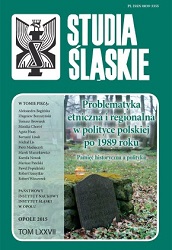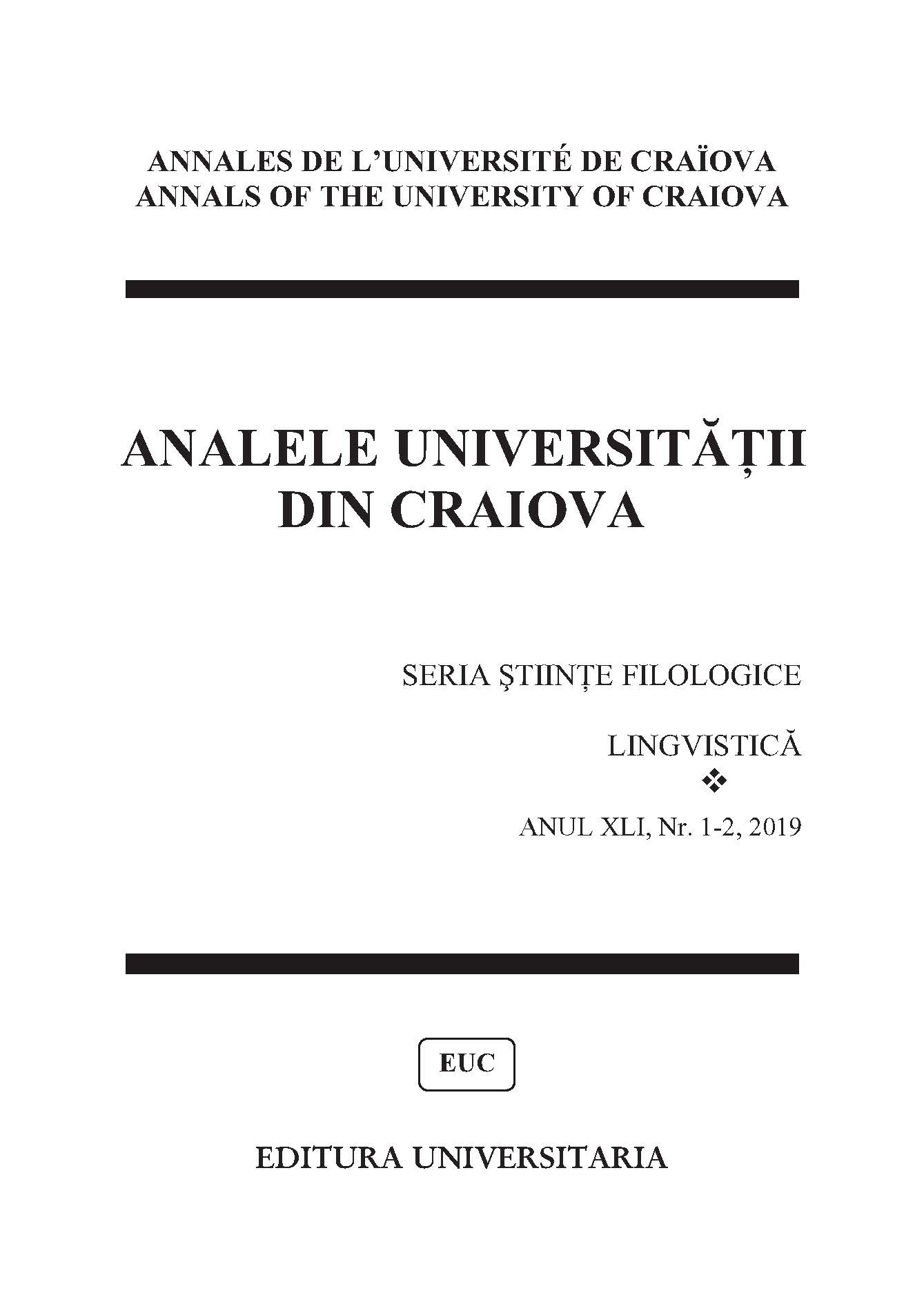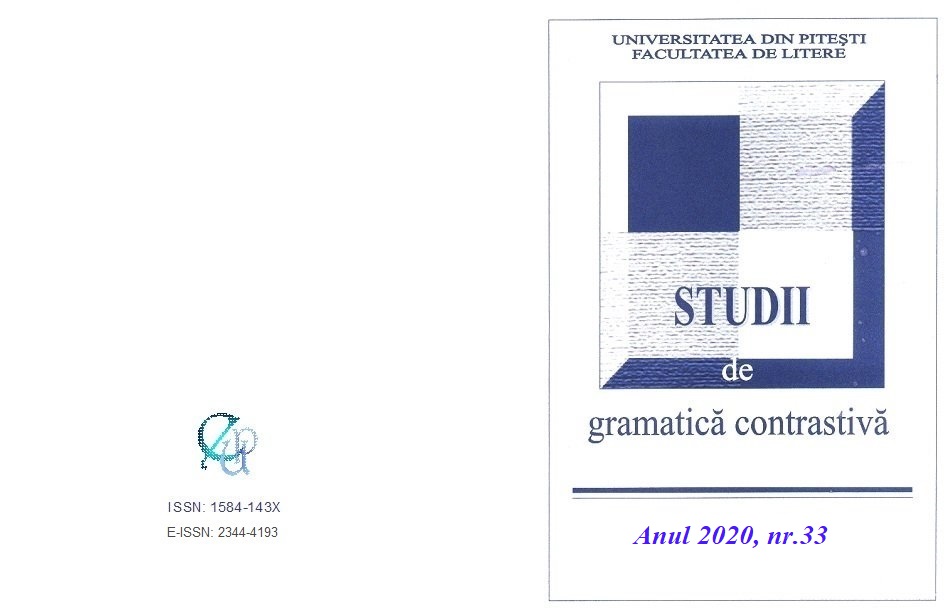We kindly inform you that, as long as the subject affiliation of our 300.000+ articles is in progress, you might get unsufficient or no results on your third level or second level search. In this case, please broaden your search criteria.

A river that provides with a life-giving water, creates the capability of natural defense, facilitates communication always enticed the man to settle over it. The dangers of the neighborhood did not discourage him. The name of the river was often transferred to the settlements established by him. The vast basin of the Oder is and was not ethnically and linguistically consistent in the past and that diversity is also reflected in the geographical naming. The paper discusses the Polish, German and Czech place names, formed from the hydronym Oder, along its course - from its source to the estuary. It is a numerous group of names that are chronologically, semantically and structurally diversified. Most of them were established in the German language, those are both the older and the more recent names, among which a large group officially granted in the thirties of the XXth century. In linguistic terms these are assemblies consisting of the name of the river Oder and the nouns defining the nature of the object, as well as the compilations with the localizing element that indicates the position of the town by the river. At the same time, the article draws attention to various ways in which these elements may be written: as a prepositional phrase an der Oder [by the Oder], giving the name into brackets or after a slash (/). Among the Polish names, in terms of the construction of word formation, names that are equal to the name of the river may be distinguished, also through the usage of suffixes -ica, -isko, prefixes przy-, za-, and the correlation with the localization element in the form of an adjective Odrzański [adjective of Oder] or a prepositional phrase nad Odrą [by the Oder]. Czech names are less numerous, which probably arises from the fact that the river Oder flows through that country on a relatively short distance. Here the prepositional names with a localization element nad Odrou [by the Oder] outweigh.
More...
In 1939 the American philosopher W.M. Urban published a massive treatise on language philosophy entitled Language and Reality. In the ’50s, during his stay in Uruguay, as a professor of linguistics at the University of Montevideo, Eugenio Coseriu read attentively this work and retained some elements (evocative functions, universe of discourse, elliptical character of language, etc.), taking them over in his integral linguistics. In this article, I aim at identifying these concepts (essential for Coseriu’s linguistic theory), relating them to the original contexts of W.M. Urban’s treatise.
More...
This paper reviews significant scientific literature on Dongba and Daba oral traditions. Studies in this field are currently at a preliminary stage. Oral literature carries ancestral knowledge and wisdom in illiterate contexts. However, the oral features of Dongba scripture have been scarcely analysed in previous studies, while Daba oral texts have not yet been systematically documented. The present work shows the more significant aspects of current studies on Dongba and Daba oral traditions, commenting on the main achievements and highlighting topics that require further research.
More...
Les expressions idiomatiques sont très répandues dans le discours journalistique. Dans ses écrits, le journaliste cherche à créer un effet, à rendre son texte attrayant pour le lecteur. À travers l’étude de notre corpus (Le Quotidien d’Oran), nous avons constaté la place importante qu’occupent les expressions figées dans ce journal et plus précisément les expressions idiomatiques verbales(EIV). Notre étude vise à mettre en évidence l'impact des expressions idiomatiques verbales sur les comportements sociolinguistique des lecteurs de la presse francophone. A cet effet nous avons confectionné un questionnaire destiné à un nombre de lecteurs (catégories sociales différentes) afin de montrer d’une part le rôle que jouent ces expressions dans la production du sens, et d’autre part d’analyser les raisons de leur adoption par le journaliste dans le contexte, ici articles de presse.
More...
Langue Adamawa-oubangui parlée au sud-ouest du Tchad et au nord-est du Cameroun, ayant près d’un million de locuteurs, le tupuri est en étroite cohabitation avec le français dans cette région frontalière de l’Afrique Centrale. Dans cet article, nous étudions le système de tupurisation phonologique, c’est-à-dire les caractéristiques phonétiques du français véhiculaire en milieu tupuri : il s’agit de décrire notamment les néologismes et les chevauchements tonologiques qui naissent des systèmes phonétiques des deux langues en contact. Le français parlé par les locuteurs natifs tupuri à l’Extrême-Nord camerounais apparaît comme le véhicule d’un patrimoine vocalique
More...
Le présent article propose une étude questionnant les limites de la représentativité d’un corpus strictement linguistique dans le cadre d’une analyse contrastive portant sur le caractère analogique des désignations vernaculaires de poissons méditerranéens. Il traite du caractère évolutif de ce type de corpus, étant donné son extension vers des domaines autres que le domaine linguistique, à savoir, le domaine sémiotique et le domaine des sciences de la vie.
More...
La problématique de l’usage la langue française en Afrique a toujours alimenté la recherche scientifique et universitaire. La réflexion actuelle s’interroge sur la récurrence et la pérennité des « fautes » syntaxiques dans l’expression écrite des élèves de troisième pourtant outillés par les leçons de grammaire depuis l’école primaire. Ce raisonnement se perçoit comme une pratique sur laquelle il est nécessaire de s’attarder d’autant plus que la norme scolaire vulgarisée par les pouvoirs publics et les enseignants n’a jamais été prise en compte par certains contextes sociolinguistiques. Il se trouve que la socioculture considérée comme un prisme dans les procédés d’écriture de ces élèves, influence majoritairement ces procédés que nous pouvons taxer d’indigène. Or l’expression écrite a toujours été considérée comme étant une langue correcte, pure, réfléchie, normée. Les éléments du corpus que nous avons répertoriés montrent vraiment une langue distincte du français. Les pratiques écrites de la langue française de ces apprenants l’attestent bien. Telles sont des confusions et des généralisations grammaticales relevées dans des copies des élèves. Cet article se propose ainsi de décrire, d’analyser et de comprendre le caractère continuel de quelques « fautes » d’accord du français écrit des élèves de cette classe à partir de sa forme écrite normative.
More...
Dans cet article, nous allons travailler sur le langage SMS des étudiants du Département de Français de la Faculté des Lettres et Langues de l’Université Mouloud Mammeri de Tizi-Ouzou, Algérie. Nous allons, dans un premier temps, présenter une introduction qui consistera en un rappel ou plus précisément en une caractérisation du langage SMS. Dans un deuxième temps, il s’agira de présenter nos informateurs étudiants qui sont au nombre de 40 garçons et filles, puis de recueillir un ensemble de SMS et un ensemble de copies d’examen qui constitueront notre corpus, corpus que nous soumettrons par la suite à l’analyse linguistique. Nous comprendrons à l’issue de cette analyse que la pratique langagière de SMS a une incidence sur la pratique du français standard écrit des étudiants. Autrement dit, le langage SMS est responsable en partie des fautes à l’écrit normé des étudiants.
More...
Cet article se propose d’étudier les rapports qui existent entre la néologie et la nomination, tous les deux comme aspects processuels de formation, et néologisme et dénomination comme résultat, et produit de l’acte. Le besoin de donner un nom à un nouvel objet, un nouveau produit, nouveau référent, est toujours l’argument invoqué pour justifier la création des néologismes .L’idée de base est de se pencher sur l’acte même de la création lexicale, plus précisément la morphologie du nom propre. On établira dans un premier temps une comparaison entre les notions qui restent assez floues, parfois opposées néologie/néologisme et nomination/dénomination, on étudiera par la suite quelques néologismes de nomination de produits de consommation. On va essayer de démontrer à travers quelques exemples, quels sont les procédés de création lexicale utilisés par les concepteurs de noms de marque et de produits pour promouvoir ces derniers sur un marché inondé par les produits de consommation.
More...
Dans cette étude, nous nous proposons d’examiner une formule de clôture des échanges téléphoniques (mais pas seulement) qui semble l’emporter en Roumanie sur les autres formules ayant la même fonction. Nous pensons que le recours à cette formule inédite (non enregistrée pour le moment dans le code des bonnes manières, ni dans les guides de conversation du roumain) témoigne d’une intention d’originalité, mais elle présente en même temps un certain écart par rapport aux formules consacrées, avec des effets particuliers sur la relation des interlocuteurs. L’étude se propose justement de rendre compte de cet écart, en essayant de proposer une explication de la « fortune » dont la formule jouit ces derniers temps.
More...
Cet article met en exergue le contexte et les conditions dans lesquels l’abouré et l’abron, deux langues appartenant à la famille Kwa, procèdent pour la formation du pluriel de mots composés. En tant que fait de langue caractérisé par des marques reconnaissables dans les langues, le pluriel peut être entendu comme l’expression de la forme particulière d’une unité linguistique (ici complexe) indiquant un nombre supérieur à l’unité considérée.Certes, la manifestation du pluriel des mots, qu’ils soient simples ou complexes n’est pas spécifique, voire une originalité des deux langues. Des études comme celles de Anne-Marie B. (1990), Blaise Mouchi (2006), Jérémie Kouadio et Dénis Cresseils (1977) ont montré que le pluriel est une propriété universelle du langage. Dans le cadre spécifique de l’abouré et de l’abron, la marque du pluriel des mots complexes est reconnaissable par des formes phonétiquement marquées reposant sur deux procédés majeurs. Ainsi, en abouré, nous avons la consonne homorganique / N/ et le morphème /mɩ / qui permettent la formation du pluriel. Quant à l’abron, elle forme son pluriel avec les morphèmes / nɷm/ et /fὼɔ/ suffixés au mot. A ces deux formes, s’ajoute l’archiphonème /N/ qui se réalise différemment sous certaines conditions.
More...
This paper is aimed at highlighting the equivalence relationship between French proverbs and their translation into Romanian. First of all, the frozen character of proverbs, proverb freezing and defreezing potential will be tacked with. An analysis of cultural connotations of animals used in French proverbs and their equivalent in Romanian will be followed by a short presentation of the similitudes and differences between French and Romanian proverbs. Finally, some translation methods will be presented as solutions for cultural connotation transfer from one language to the other.
More...
The paper aims at presenting the types of predicates specificity in both English and Romanian. In English, a predicate consists of a verb in a personal mood either expressed or implied. The predicate classification is made according to the criterion of content and to that of structure. There are verbal predicates, nominal predicates and mixed types of predicates. In Romanian, there are verbal predicates and nominal predicates as well, and there are distinct types of predicates – adverbial and interjectional.
More...
The phenomena of grammatical metamorphosis are very recurrent in grammatical and contextual uses: the first is that of the migration from one class to another; a majority of DM is built from the decategorization - reclassification of morphemes belonging to other classes. The second is that of the opacity of the boundaries between the different markers.In the context of this paper, we will focus on the various canonical and contextual uses of the "but" connector by supporting, through examples, this categorical instability.
More...
Although the analyst asks himself what humor is, (Noguez : 2000), the raised problem do not prevent the various manifestations of the questionned reality. On the contrary : in its written, gestural and verbal forms, humor stays an human activity with a social dimension that leans laughing to the group’s experiences (Bergson : 1900). That’s why, there is an « jewish humor » (Klatzmann : 1998), different of an ivorian humor, for example. In Ivory Coast, a long tradition of derision, powered by the social contexts and carried by the media and the artists, helped to create a type of humor. Certainly, books with funny stories are not successful, but the zouglou , the nouchi and the verbal performances of humorists make humor becomes today a prized art that have orality as pedestal (Tidou: 2015). So, with annual TV shows as Bonjour (the year), the ivorian humor forges itself an identity based on oral invariants.Between (self)derision and funny stories, relationship to colonial language (french) and reception of several waves of migrants, collective history and individual experience (and this one depends to that one) chewed by the verbal performance of humorists, for us, it’s about deciphering the oral invariants that specify humor from Ivory Coast to make it becames ans specific ivorian humor.
More...
This contribution is intended to be a sociolinguistic study on the use and place of the French language among sub-Saharan students pursuing their studies in Algeria. Our main objective is to describe and evaluate the language practices adopted by the said students in the different communication situations as well as in their relations with those around them where sustained attention will be paid to French as the language of training in the differents disciplines in Algeria.
More...
The Vegetal Model in Conceptualising Creation. Our study intends to formulate a number of hypotheses about the manner in which the idea of creation has been conceptualised both in the case of the largest and most fascinating of all creation acts, namely genesis, and in the case of the creation of other forms of existence, on a number of its levels: human, vegetable, animal or mineral. Our reflections start from a number of conceptual metaphors of creation, identified in the biblical text, in order to compare them to those from cosmogonic myths, popular beliefs or folkloric texts (folktales, incantations, carols, etc.) that refer to various types of creation: the creation of the Earth or of the Sun and the periodic regeneration of time, the conception of the human being or of baby animals, the creation of familial and social relationships, the generation of speech, of feelings or of the qualities of beings and things or even of disease. Their analysis emphasises the predominance of a vegetal pattern, which constitutes a factor of coherence for various types of creation representation, seemingly extremely different. By keeping in mind what profound significance the “modest” seed, which sheltered the mystery and force of the universal creation, has had in the mythic-magical mentality, the study shows in what way this mentality has influenced the individual’s manner of understanding the world and of relating to it. Although, at first glance, it is about a micro-metaphor negligible through its dimensions, completely ignored by today’s speakers, especially after the removal of human from agricultural occupations and from nature, in general, we consider that it deserves recovering its fundamental significations. It is only this way that we will be aware of its status as a nucleus of a conceptual scheme that is intimately connected to the vegetal cycle of wheat, started by sowing and concluded not by harvesting, but by its transformation into bread. The latter, in its turn, conserves the fertilizing strength of the wheat grain, which it can return, through magical means, to the seed put into the ground the next year. In fact, even if today’s speakers have forgotten its former deep significations, it is one of the perpetual metaphors whose life continues through the daily use of linguistic expressions that encode it.
More...
Eotile also known as bétiné is a Kwa language (J. Stewart 1989, K. Williamson and R. Blench 2000) from Côte d'Ivoire, a country in West Africa. Originally homogeneous, it split (H.Dagri-Diabaté 1984) into two varieties, adiaké and vitré, around the 18th century; inducing in synchrony different degrees of vitality and an evolution in distinct sociolinguistic environments. In fact, the adiaké spoken in the eponymous locality, with six speakers, is moribund (A.F.Kakou 2014). The vitré in Grand-Bassam is dynamic with around 3,500 speakers (T. L. Ahaté 2008, A. F. Kakou 2009). The opposite trajectories of these bétiné dialects have certainly resulted in linguistic variations. Hence the conduct of this study whose central question is to know what are the forms and syntax of the grammatical marks of the éotilé. The aim is to make a comparative inventory of these morphemes. To do this, the analyzes focused on a corpus made up of 800 lexemes and statements. From their examinations, it emerges that the dialects of the éotilé have in common bound and free grammatical morphemes. However, there are also some differences in form and syntax in these grammatical units.
More...